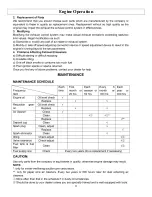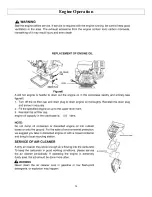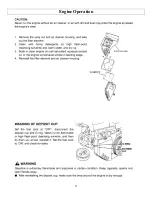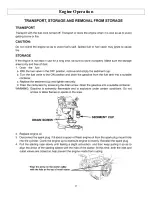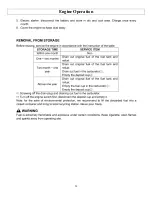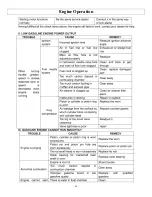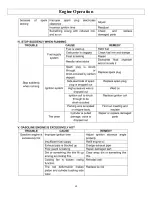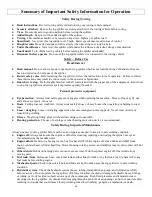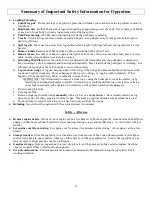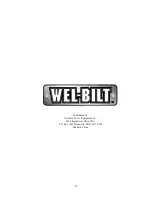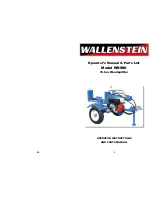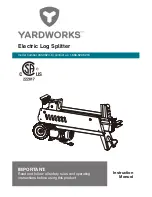
Summary of Important Safety Information for Operation
67
●
Loading/Unloading
●
Unsplit log pile
. Do not pile logs to be split in a place that will make you reach across the log splitter in order to
load them.
●
Hold bark side
. Hold the bark side of logs when loading or positioning, never the ends. Never place your hands
or any part of your body between a log and any part of the log splitter.
●
Push Plate moving.
NEVER load or unload logs while the push plate is moving
.
●
Cracks
. Cracks in logs can close quickly and pinch fingers. Keep fingers away from any cracks that open in
partially split logs.
●
Split log pile
. Move each log away from log splitter after it is split. Split logs left near the log splitter are a trip
hazard.
●
Remove hands.
Remove both hands from log before activating Split Control Lever.
●
Hand activate.
Use only your hand to operate the Split Control Lever. Never use any other body part, or a rope,
cable, or other remote device to actuate the control.
●
Returning Push Plate.
Once the control valve is actuated in the return direction, the push plate is designed to
keep returning by itself completely and then stop automatically. Stay clear while the push plate is returning. It is
still powerful enough on the return stroke to cause serious injury.
●
Log stuck on wedge
. A log can become stuck to the wedge if the wedge becomes embedded in the log and the
log doesn’t split and separate. This can happen if the log is too stringy or tough to split completely. If this
happens, follow the directions below to manually remove the log:
IMPORTANT
:
NEVER attempt to remove a stuck log by using the hydraulic force of the splitter, or by
modifying or adding attachments to splitter. Personal injury could result from log or metal pieces flying
out at high speed toward the operator or bystanders, or the splitter could become damaged.
1.
Retract push plate fully.
2.
Turn engine OFF.
3.
Remove stuck log from the wedge
manually
with a pry bar or a sledgehammer. Be extremely careful, as log
pieces may fly off as they separate from the wedge. Wear safety goggles and make sure bystanders are clear.
4.
Do not attempt to resplit a stuck log once it has been removed from the wedge.
●
Refueling.
Never refuel the engine until it has cooled at least two minutes.
Safety – After use
●
Remove engine debris
. Debris on a hot engine can be a fire hazard. With the engine off, clean debris and chaff from
engine cylinder head, cylinder head fins, blower housing rotating screen, and muffler areas. Avoid contact with hot
muffler.
●
Let engine cool before storing.
Let engine cool for at least five minutes before storing. A hot engine can be a fire
hazard.
●
Storage location.
Store the log splitter in a location away from sources of heat, open flames, sparks or pilot lights –
such as water heaters, space heaters, furnaces, clothes dryers, or other gas appliances. Even if the log splitter’s gas
tank is empty, residual gasoline vapors could ignite.
●
Gasoline storage.
Store extra gasoline in a cool, dry place in an UL approved, tightly sealed container. Gasoline
vapors can ignite if they collect inside an enclosure.
●
Periodic maintenance.
Perform periodic maintenance as directed in this manual to keep the log splitter in safe
working condition.
Summary of Contents for M141300A
Page 2: ...Hazard Signal Word Definitions 2...
Page 6: ...Safety Label Locations 6 1 7 2 3 4...
Page 7: ...Safety Label Locations 7 8 5 13 12 10 11 14...
Page 8: ...Safety Label Locations 8 15 16 19 18 17 9 6...
Page 33: ...Parts Breakdown Exploded View 141300 Rev A 33...
Page 39: ...Parts Breakdown Exploded View 141300 Rev A 39...
Page 42: ...Engine Parts Breakdown Exploded View 141300 Rev A 42...
Page 47: ...Engine Operation 47...
Page 48: ...Engine Operation 48...
Page 49: ...Engine Operation 49...
Page 50: ...Engine Operation 50...
Page 51: ...Engine Operation 51...
Page 52: ...Engine Operation 52...
Page 53: ...Engine Operation 53...
Page 54: ...Engine Operation 54...
Page 55: ...Engine Operation 55...
Page 56: ...Engine Operation 56...
Page 57: ...Engine Operation 57...
Page 58: ...Engine Operation 58...
Page 59: ...Engine Operation 59...
Page 60: ...Engine Operation 60...
Page 61: ...Engine Operation 61...
Page 62: ...Engine Operation 62...
Page 63: ...Engine Operation 63...

